Application of Electro-Hydraulic Actuator System to Control Continuously Variable Transmission in Wind Energy Converter
Abstract
1. Introduction
2. Description of System
3. System Modeling and Problem Statement
3.1. Wind Model
3.2. CVT Modeling
3.3. EHA Modeling
4. Control Design
- Rule 1: If s is the ZE then ɷhit is the ZE
- Rule 2: If s is the P01 then ɷhit is the P01
- Rule 3: If s is the P02 then ɷhit is the P02
- Rule 4: If s is the P03 then ɷhit is the P03
- Rule 5: If s is the N01 then ɷhit is the N01
- Rule 6: If s is the N02 then ɷhit is the N02
- Rule 7: If s is the N03 then ɷhit is the N03
5. Experimental Evaluation
5.1. Experimental Test Rig
5.2. Experimental Results
6. Conclusions
Author Contributions
Funding
Conflicts of Interest
References
- Alkan, D. Investigating CVT as a Transmission System Option for Wind Turbines. Master’s Thesis, KTH School of Industrial Engineering and Management, Stockholm, Sweden, 2013. [Google Scholar]
- Jianchao, H.; Xiaolong, Z.; Pingkuo, L. A review on China’s wind power accommodation in the background of “Internet+” strategy. Int. J. Energy Res. 2018, 42, 1469–1486. [Google Scholar]
- Song, Y.; Wang, X.; Blaabjerg, F. Doubly Fed Induction Generator System Resonance Active Damping Through Stator Virtual Impedance. IEEE Trans. Ind. Electron. 2017, 64, 125–137. [Google Scholar] [CrossRef]
- Michalak, P.; Zimny, J. Wind energy development in the world, Europe and Poland from 1995 to 2009; current status and future perspectives. Renew. Sustain. Energy Rev. 2011, 15, 2330–2341. [Google Scholar] [CrossRef]
- Colak, I.; Fulli, G.; Bayhan, S.; Chondrogiannis, S.; Demirbas, S. Critical aspects of wind energy systems in smart grid applications. Renew. Sustain. Energy Rev. 2015, 52, 155–171. [Google Scholar] [CrossRef]
- Kumar, Y.; Ringenberg, J.; Depuru, S.S.; Devabhaktuni, V.K.; Lee, J.W.; Nikolaidis, E.; Andersen, B.; Afjeh, A. Wind energy: Trends and enabling technologies. Renew. Sustain. Energy Rev. 2016, 53, 209–224. [Google Scholar] [CrossRef]
- Moradi, H.; Vossoughi, G. Robust control of the variable speed wind turbines in the presence of uncertainties: A comparison between H∞ and PID controllers. Energy 2015, 90, 1508–1521. [Google Scholar] [CrossRef]
- Schulte, H.; Gauterin, E. Fault-tolerant control of wind turbines with hydrostatic transmission using Takagi–Sugeno and sliding mode techniques. Annu. Rev. Contr. 2015, 40, 82–92. [Google Scholar] [CrossRef]
- Mangialardi, L.; Mantriota, G. Continuously variable transmissions with torque-sensing regulators in waterpumping windmills. Renew. Energy 1994, 4, 807–823. [Google Scholar] [CrossRef]
- Do, H.T.; Dang, T.D.; Truong, H.V.A.; Ahn, K.K. Maximum Power Point Tracking and Output Power Control on Pressure Coupling Wind Energy Conversion System. IEEE Trans. Ind. Electron. 2018, 65, 1316–1324. [Google Scholar] [CrossRef]
- Muljadi, E.; Butterfield, C.P. Pitch-controlled variable-speed wind turbine generation. IEEE Trans. Ind. Appl. 2001, 37, 240–246. [Google Scholar] [CrossRef]
- Mohammadi, E.; Fadaeinedjad, R.; Naji, H.R. Flicker emission, voltage fluctuations, and mechanical loads for small-scale stall-and yaw-controlled wind turbines. Energy Conv. Manag. 2018, 165, 567–577. [Google Scholar] [CrossRef]
- Mangialardi, L.; Mantriota, G. Automatically Regulated CVT in Wind Power-Systems. Renew. Energy 1994, 4, 299–310. [Google Scholar]
- Ehtiwesh, I.A.S.; Dorovic, Z. Comparative analysis of different control strategies for electro-hydraulic servo systems. Proc. World Acad. Sci. Eng. Tech. 2009, 56, 906–909. [Google Scholar]
- Nguyen, M.T.; Dang, X.B.; Ahn, K.K. A Gain-Adaptive Intelligent Nonlinear Control for an Electrohydraulic Rotary Actuator. Int. J. Precis. Eng. Manuf. 2018, 19, 665–673. [Google Scholar]
- Jun, L.; Yongling, F.; Guiying, Z.; Bo, G.; Jiming, M. Research on fast response and high accuracy control of an airborne brushless DC motor. In Proceedings of the IEEE International Conference on Robotics and Biomimetics, Shenyang, China, 22–26 August 2004; pp. 807–810. [Google Scholar]
- Truong, D.Q.; Ahn, K.K. Force control for press machines using an online smart tuning fuzzy PID based on a robust extended Kalman filter. Expert Syst. Appl. 2011, 38, 5879–5894. [Google Scholar] [CrossRef]
- Lin, Y.; Shi, Y.; Burton, R. Modeling and robust discrete-time sliding-mode control design for a fluid power electrohydraulic actuator (EHA) system. IEEE/ASME Trans. Mech. 2013, 18, 1–10. [Google Scholar] [CrossRef]
- Perron, M.; de Lafontaine, J.; Desjardins, Y. Sliding-mode control of a servomotor-pump in a position control application. In Proceedings of the Canadian Conference on Electrical and Computer Engineering, Saskatoon, SK, Canada, 1–4 May 2005; pp. 1287–1291. [Google Scholar]
- Ahn, K.K.; Nam, D.N.C.; Jin, M. Adaptive backstepping control of an electrohydraulic actuator. IEEE/ASME Trans. Mech. 2014, 19, 987–995. [Google Scholar] [CrossRef]
- Nguyen, M.T.; Doan, N.C.N.; Park, H.G.; Ahn, K.K. Trajectory control of an electro hydraulic actuator using an iterative backstepping control scheme. Mechatronics 2015, 29, 96–102. [Google Scholar]
- Choi, B.J.; Kwak, S.W.; Kim, B.K. Design of a single-input fuzzy logic controller and its properties. Fuzzy Sets Syst. 1999, 106, 299–308. [Google Scholar] [CrossRef]
- Wang, L.X. Adaptive Fuzzy Systems and Control: Design and Stability Analysis; Englewood Cliffs: New York, NY, USA, 1994. [Google Scholar]
- Lee, H.; Tomizuka, M. Robust adaptive control using a universal approximator for SISO nonlinear systems. IEEE Trans. Fuzzy Syst. 2000, 8, 95–106. [Google Scholar]
- Do, H.T.; Ahn, K.K. Velocity control of a secondary controlled closed-loop hydrostatic transmission system using an adaptive fuzzy sliding mode controller. J. Mech. Sci. Tech. 2013, 27, 875–884. [Google Scholar] [CrossRef]
- Do, H.T.; Park, H.G.; Ahn, K.K. Application of an adaptive fuzzy sliding mode controller in velocity control of a secondary controlled hydrostatic transmission system. Mechatronics 2014, 24, 1157–1165. [Google Scholar] [CrossRef]
- Chiang, M.H.; Lee, L.W.; Liu, H.H. Adaptive fuzzy sliding-mode control for variable displacement hydraulic servo system. In Proceedings of the IEEE International Fuzzy Systems Conference, London, UK, 23–26 July 2007; pp. 1–6. [Google Scholar]
- Noroozi, N.; Roopaei, M.; Jahromi, M.Z. Adaptive fuzzy sliding mode control scheme for uncertain systems. Commun. Nonlinear Sci. Numer. Simul. 2009, 14, 3978–3992. [Google Scholar] [CrossRef]
- Nguyen, M.T.; Phan, C.B.; Ahn, K.K. Power Take-Off System Based on Continuously Variable Transmission Configuration for Wave Energy Converter. Int. J. Precis. Eng. Manuf. Green Tech. 2018, 5, 89–101. [Google Scholar]
- Naidu, N.K.S.; Singh, B. Sensorless control of single voltage source converter-based doubly fed induction generator for variable speed wind energy conversion system. IET Power Electron. 2014, 7, 2996–3006. [Google Scholar] [CrossRef]
- Carlin, P.W.; Laxson, A.S.; Muljadi, E.B. The History and State of the Art of Variable-Speed Wind Turbine Technology. Wind Power 2003, 6, 129–159. [Google Scholar] [CrossRef]
- Simanaitis, D. CVTs are coming of age. Road Track 2004, 5, 122–124. [Google Scholar]
- Kim, P.; Ryu, W.; Kim, H.; Hwang, S.; Kim, H. A study on the reduction in pressure fluctuations for an independent pressure-control-type continuously variable transmission. Proc. Inst. Mech. Eng. Part D J. Auto. Eng. 2008, 222, 729–737. [Google Scholar] [CrossRef]
- Le, T.D.; Bui, N.M.T.; Ahn, K.K. Improvement of Vibration Isolation Performance of Isolation System Using Negative Stiffness Structure. IEEE/ASME Trans. Mech. 2016, 21, 1561–1571. [Google Scholar] [CrossRef]
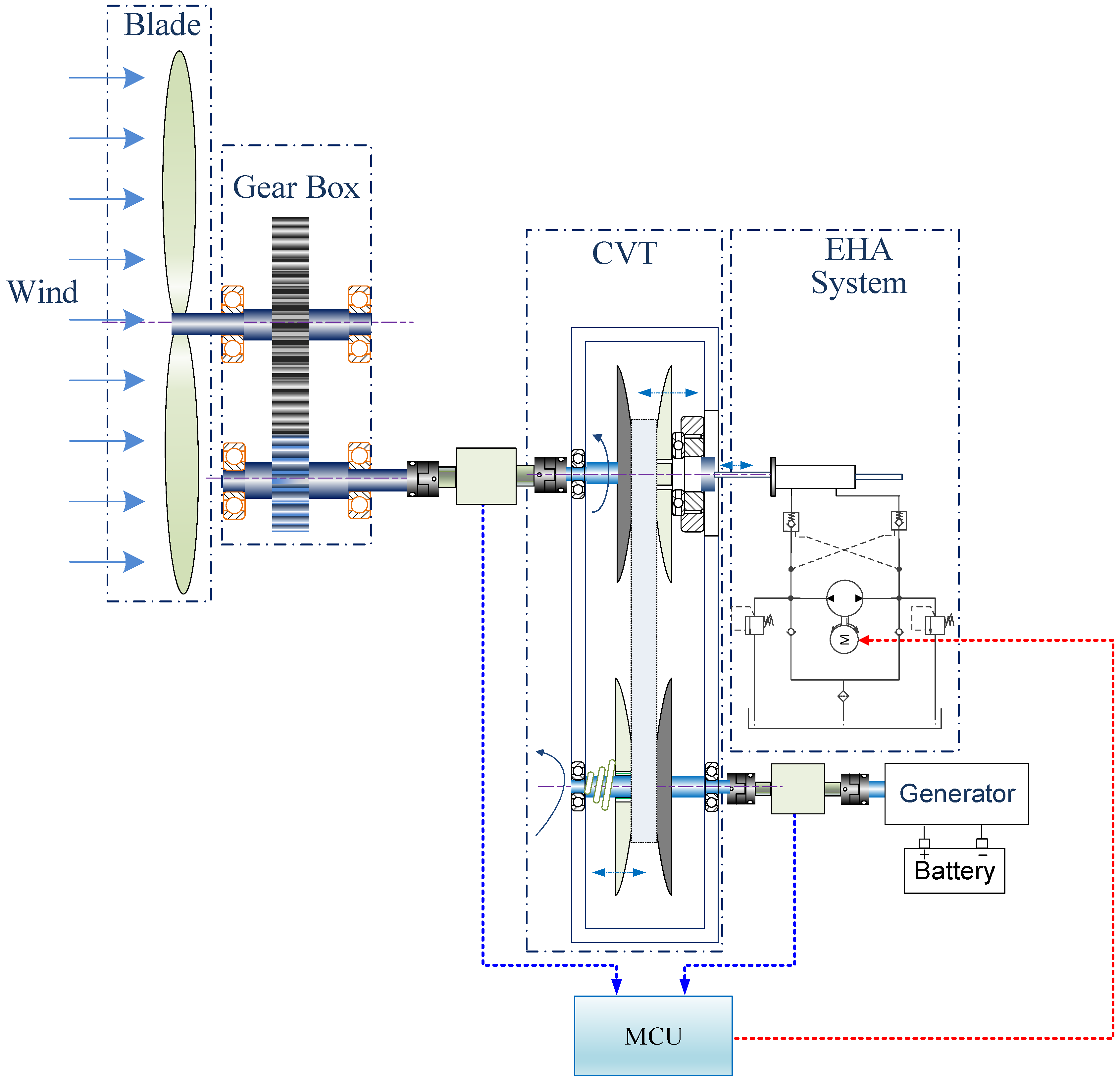
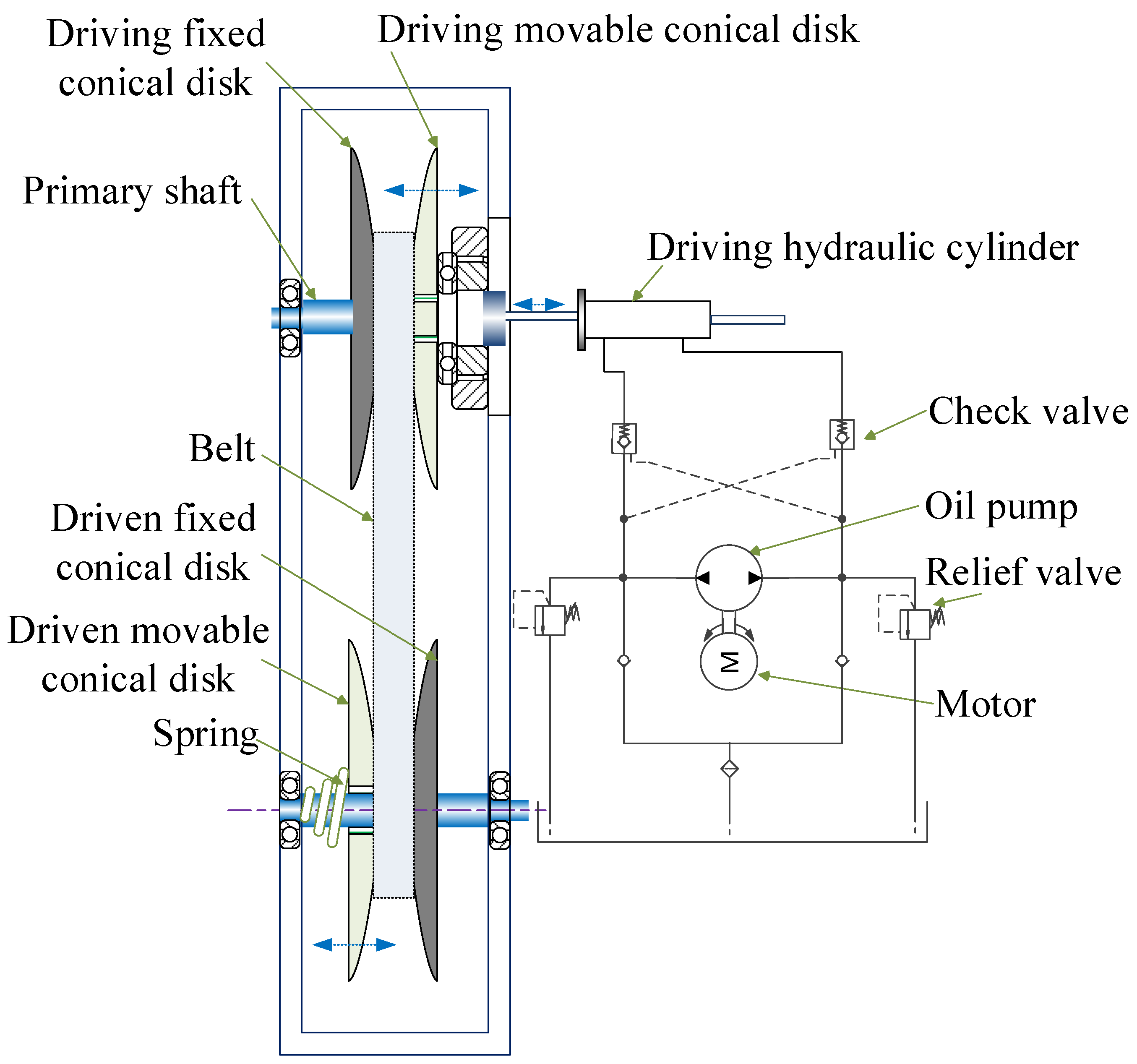

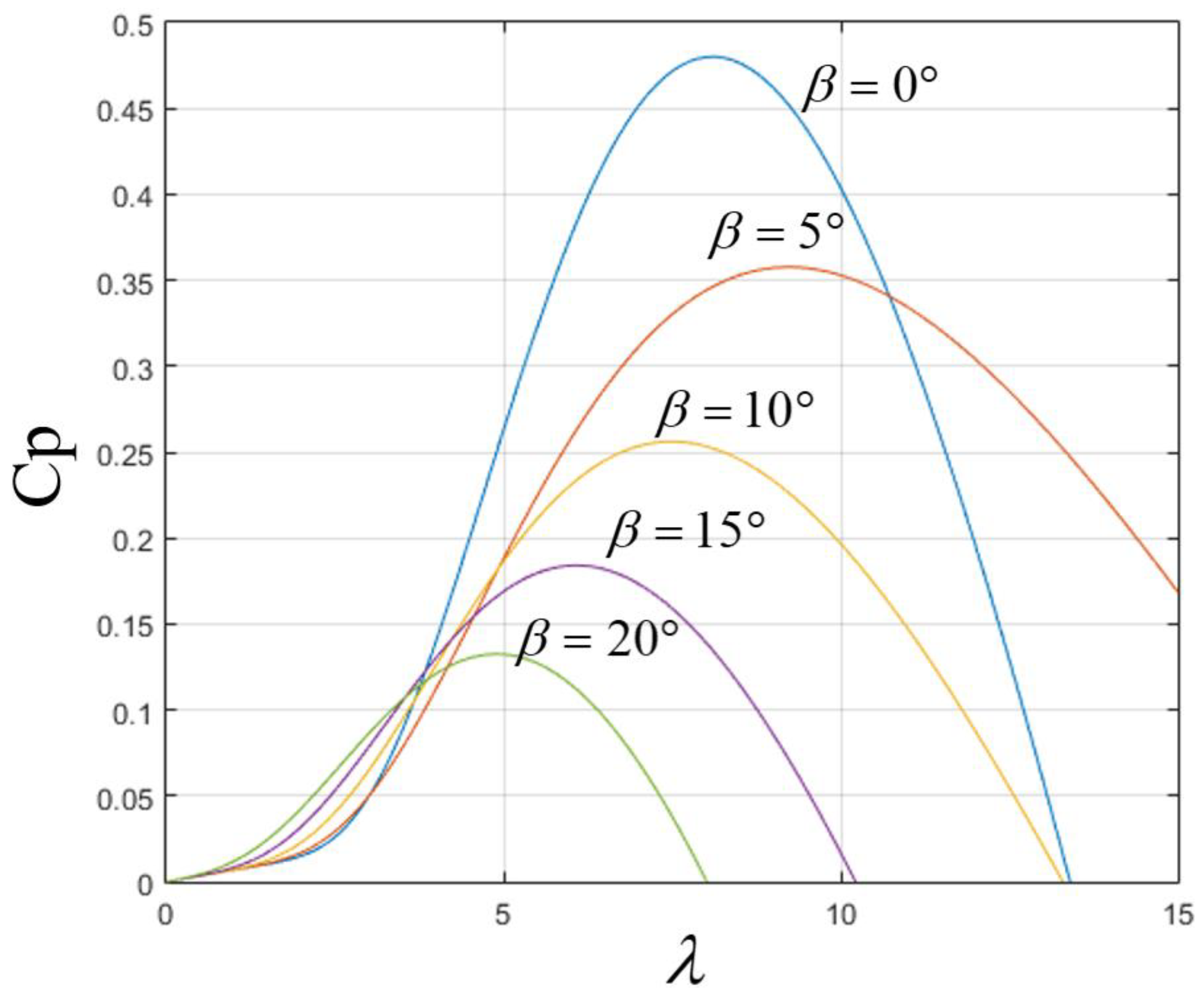

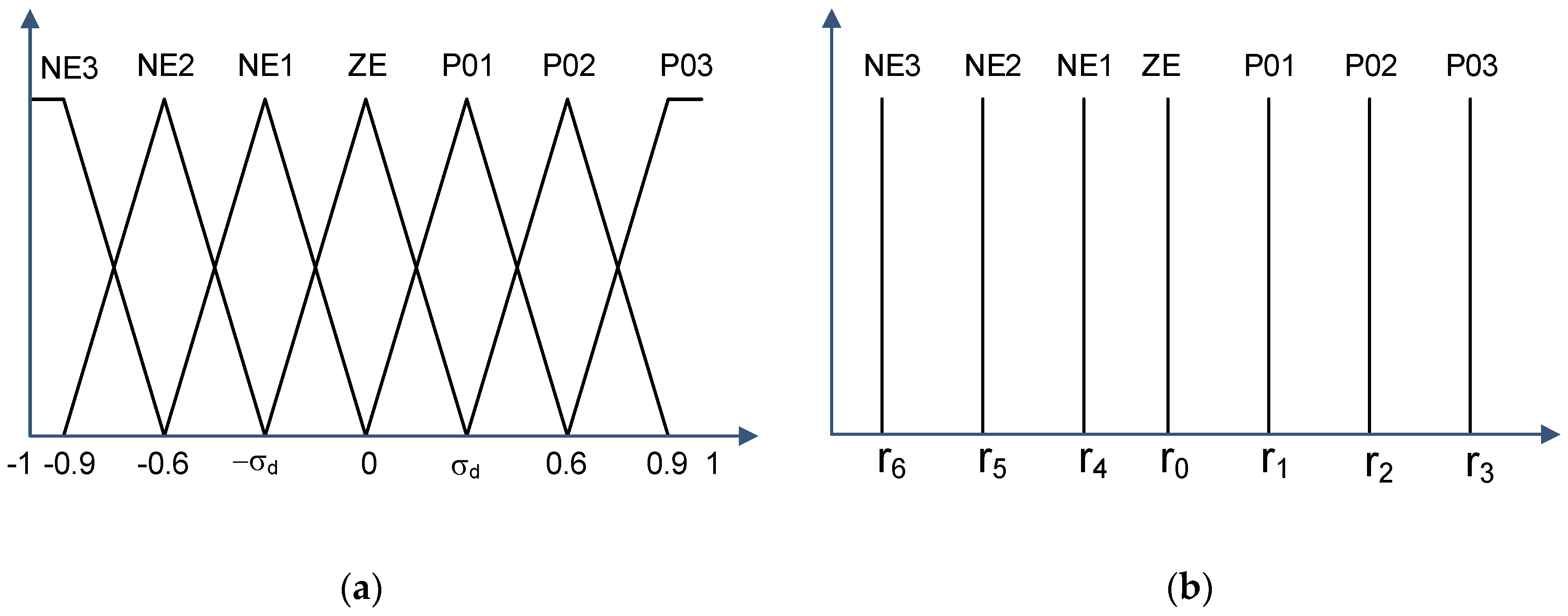
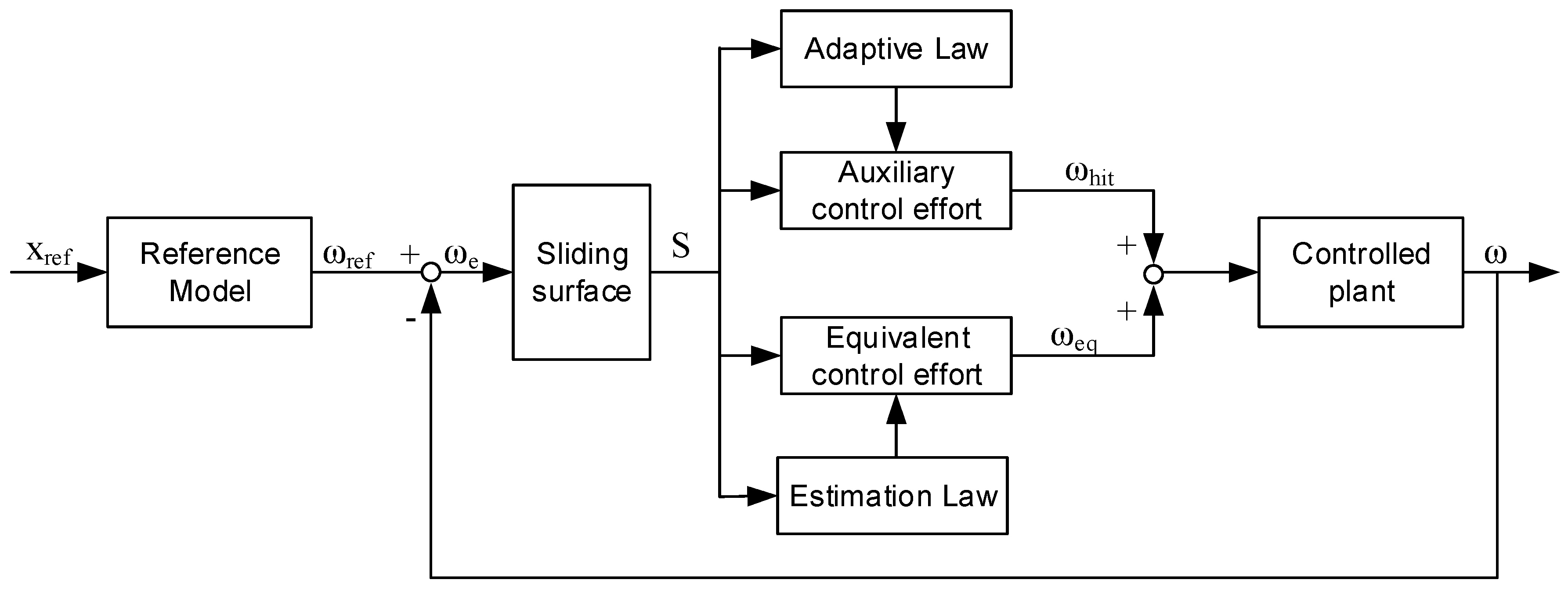
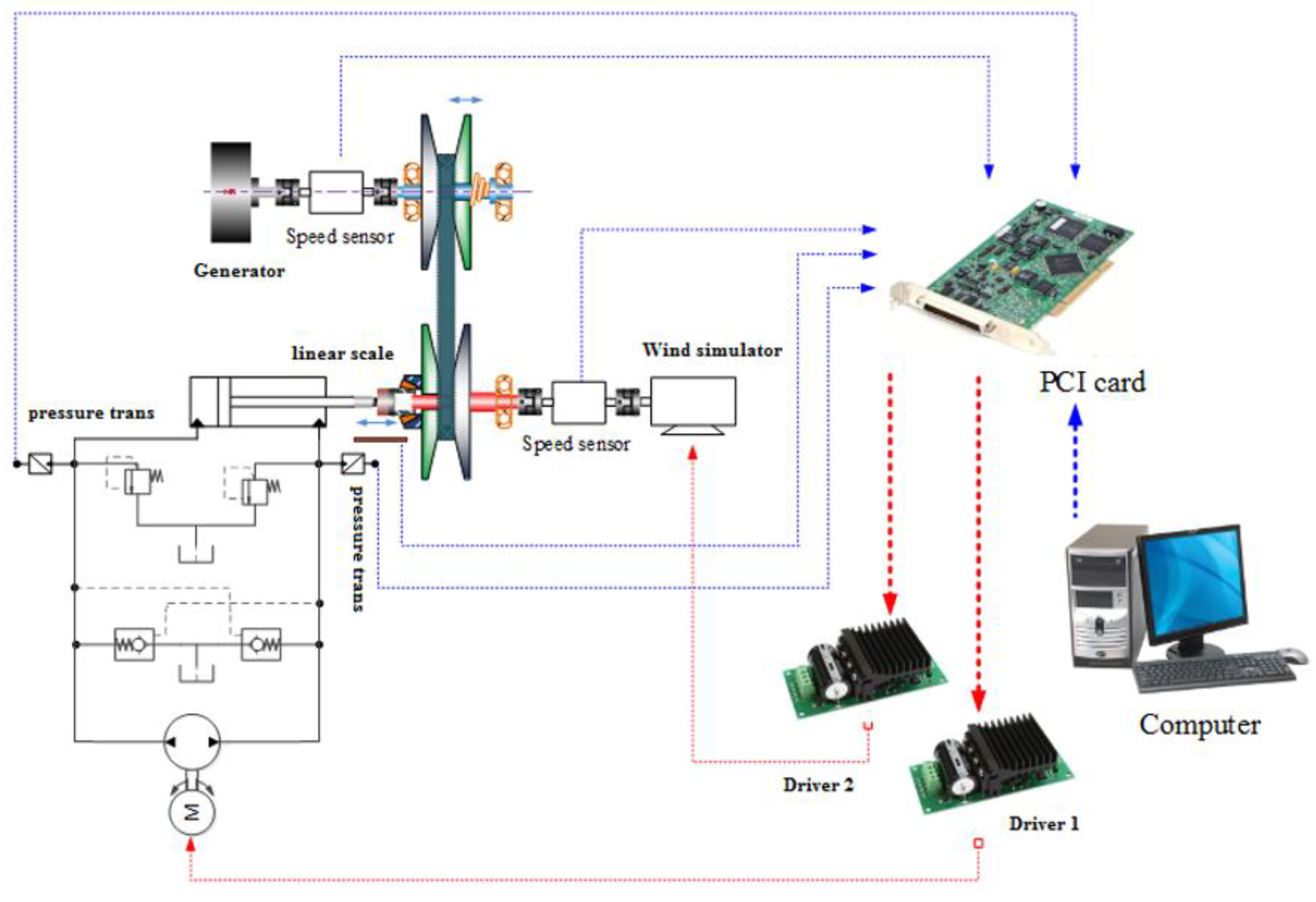
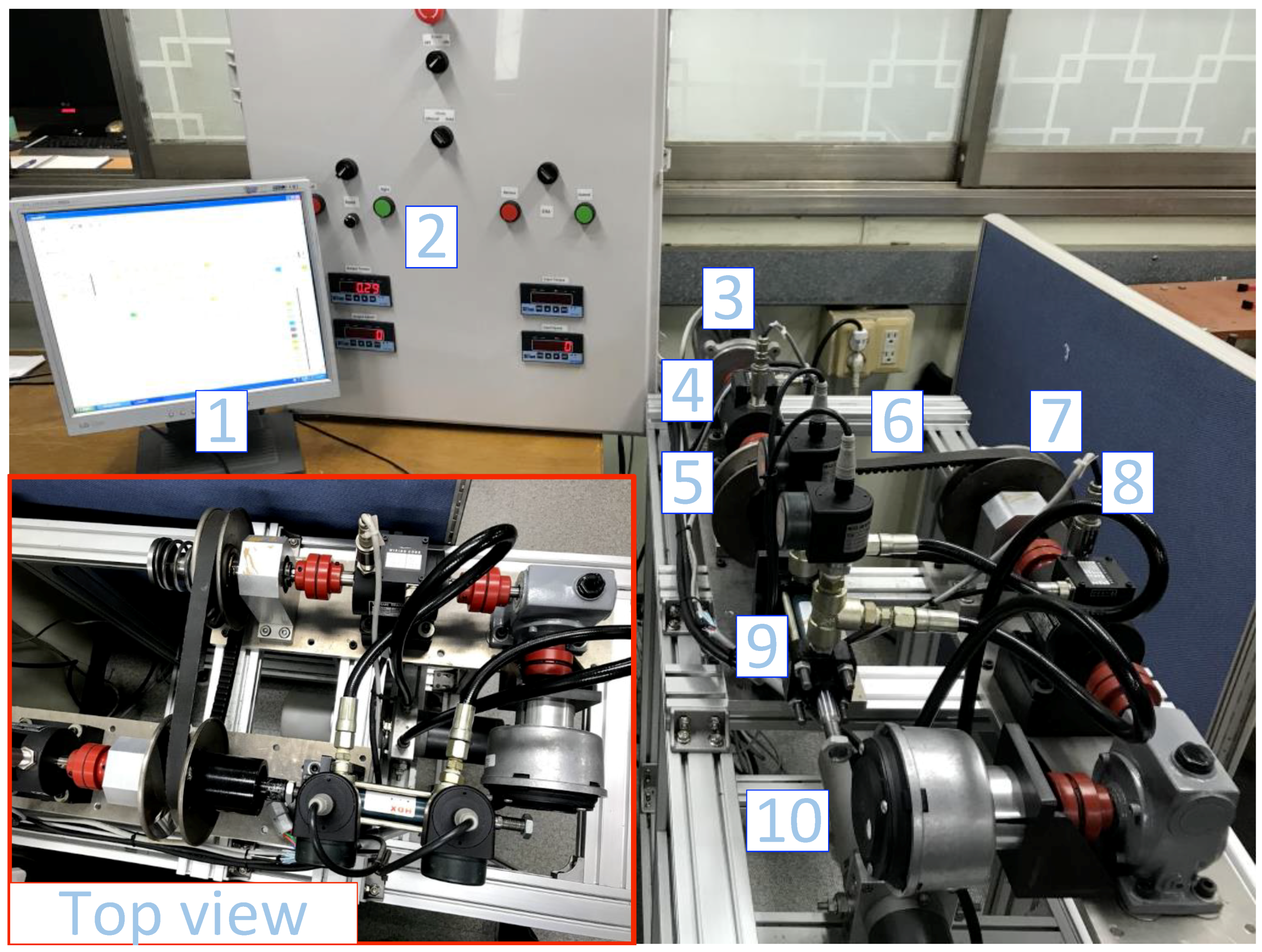
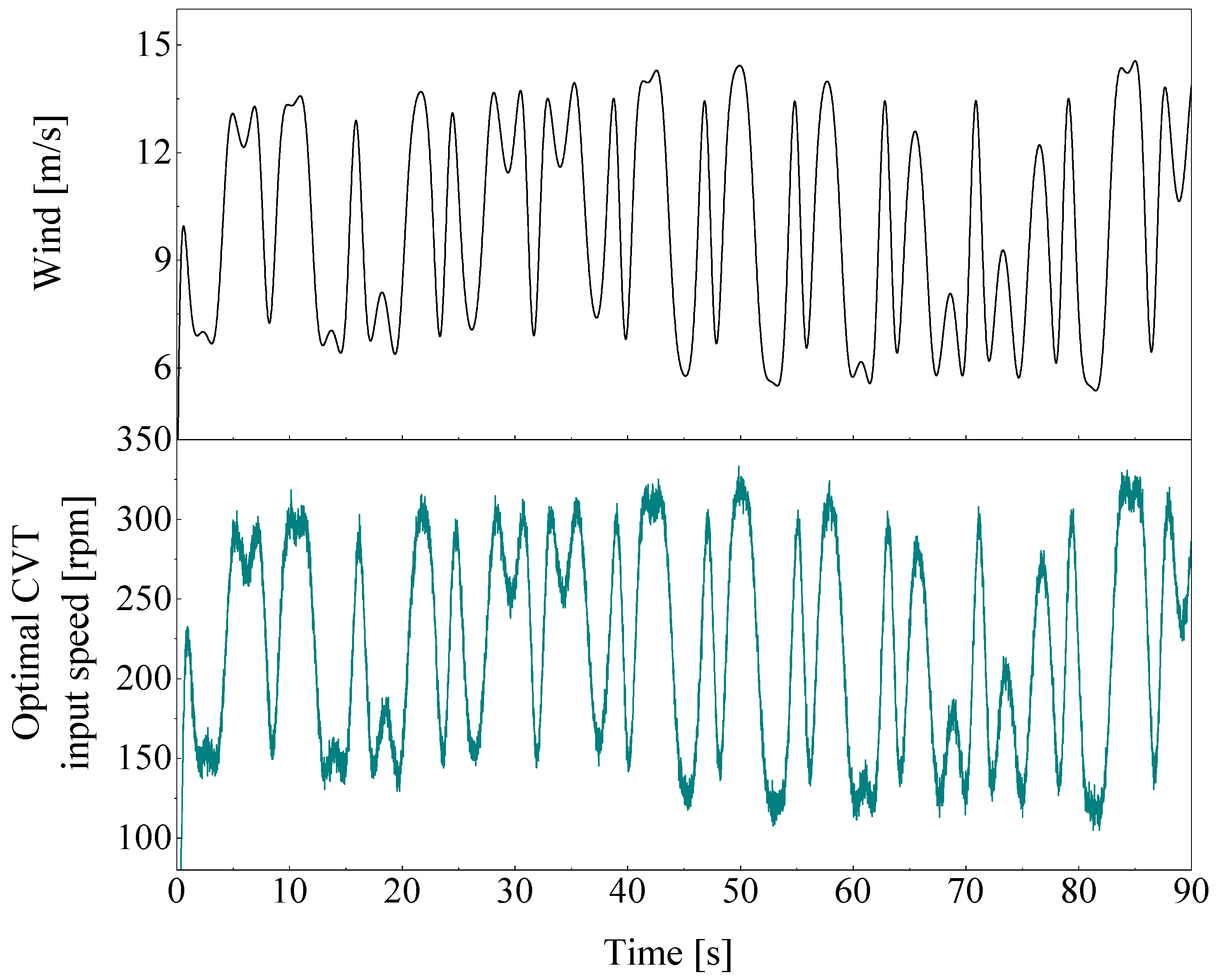
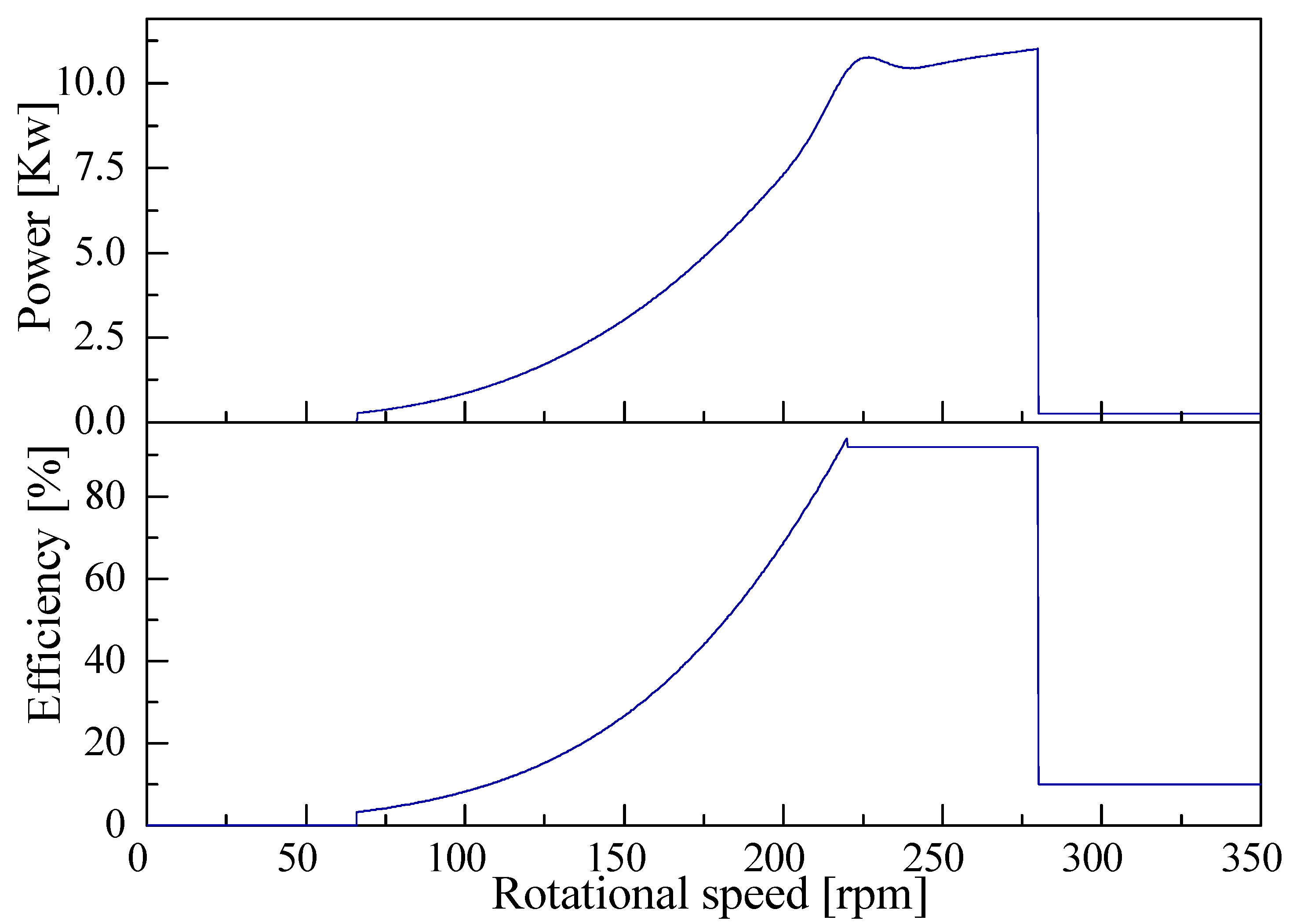
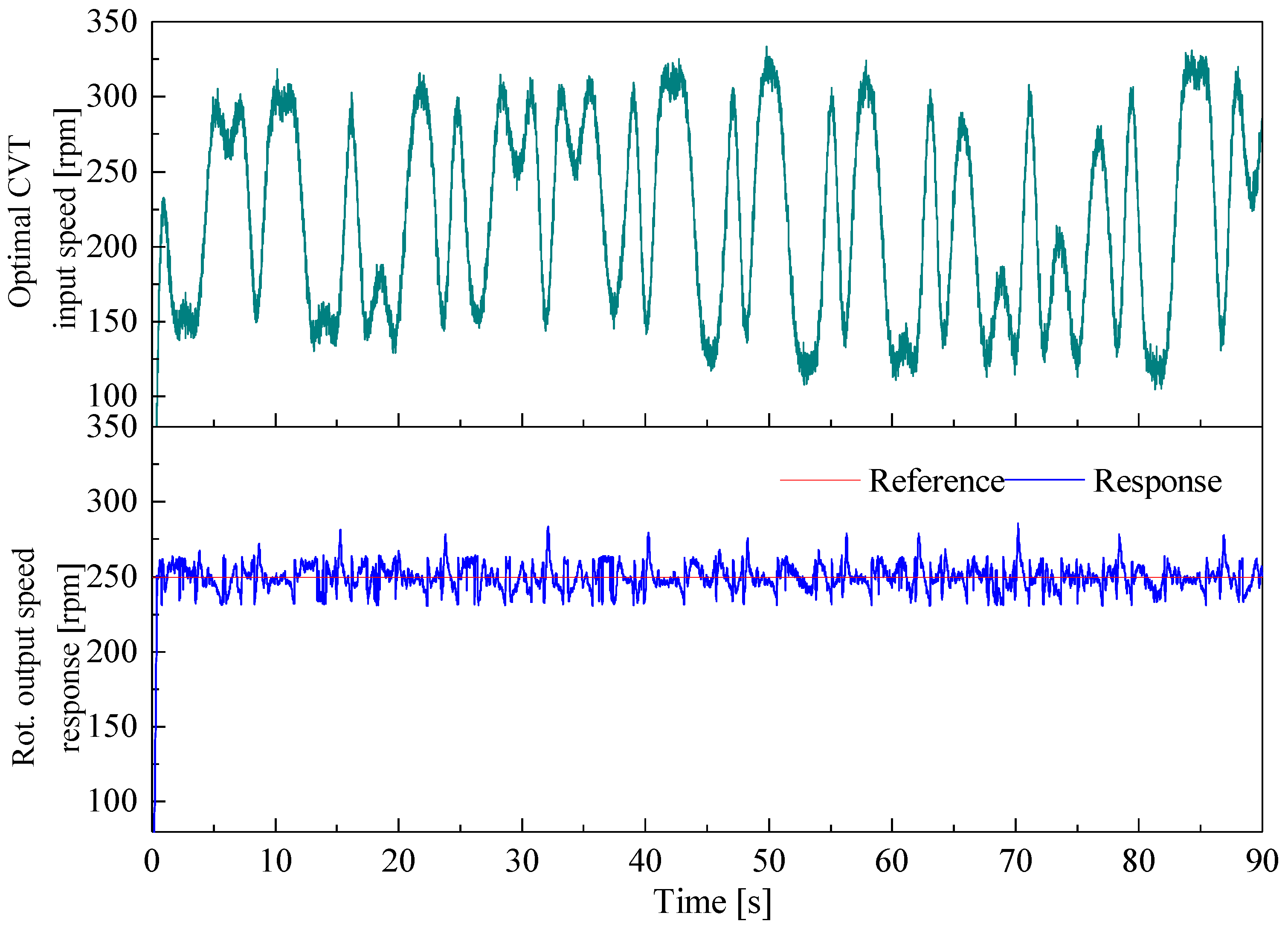

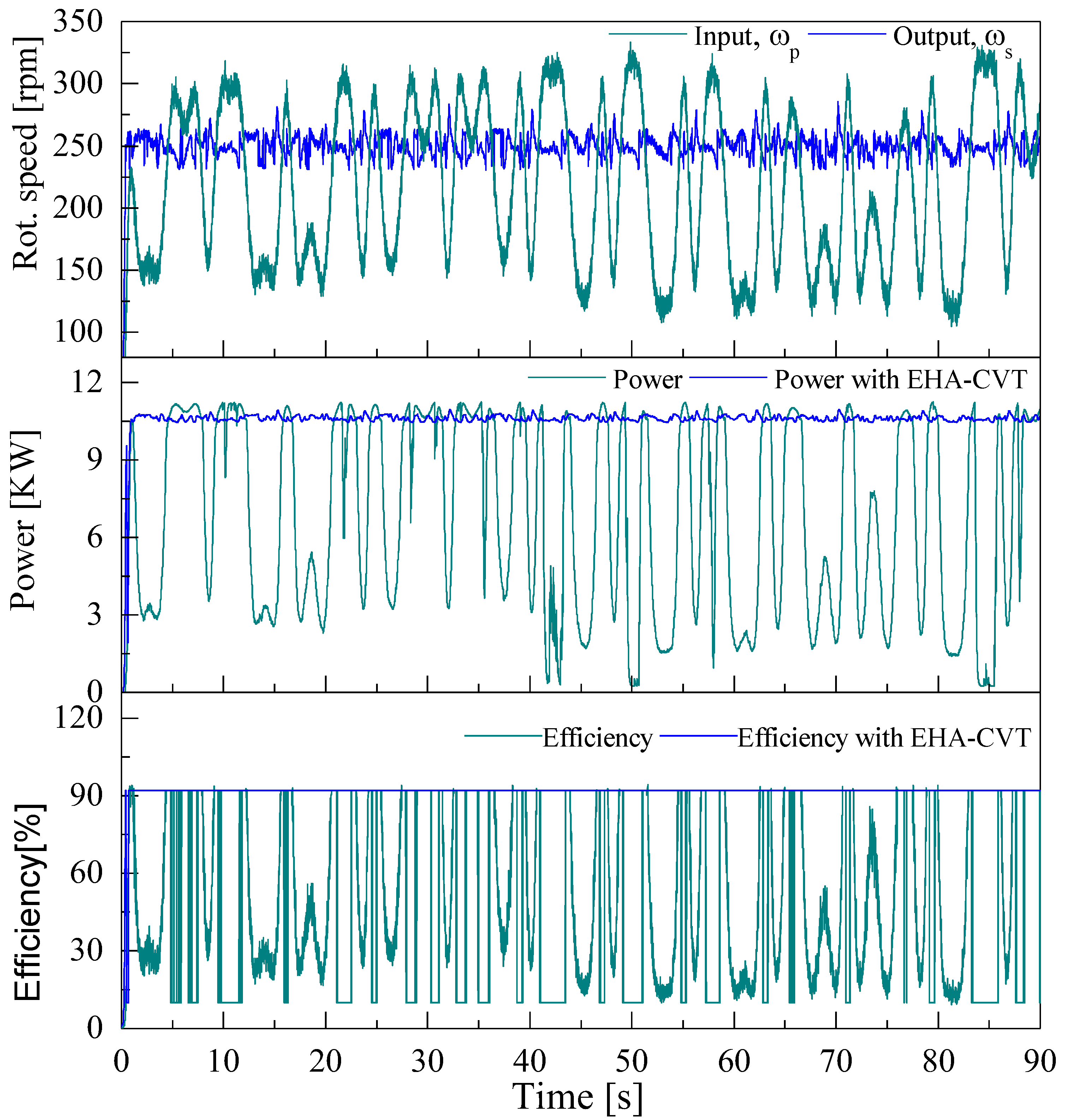
| Components | Parameters | Specification |
|---|---|---|
| Hydraulic Pump | Displacement Rated rotational speed Relief pressure Tube diameter (D) | 0.97 (cc/rev) 3000 (rpm) 100 (bar) 20 (mm) |
| Hydraulic Cylinder | Rod diameter (d) Length of stroke | 15 (mm) 25 (mm) |
| Hydraulic oil | Effective bulk modulus Specific gravity | 1.5 × 109 (Pa) 0.87 |
| Specifications | Parameters |
|---|---|
| Belt length (L) | 800 (mm) |
| Distance between two units | 250 (mm) |
| Open angle of two units | 12 (degree) |
| Rated speed for generator | 250 (rpm) |
© 2019 by the authors. Licensee MDPI, Basel, Switzerland. This article is an open access article distributed under the terms and conditions of the Creative Commons Attribution (CC BY) license (http://creativecommons.org/licenses/by/4.0/).
Share and Cite
Nguyen, M.T.; Dang, T.D.; Ahn, K.K. Application of Electro-Hydraulic Actuator System to Control Continuously Variable Transmission in Wind Energy Converter. Energies 2019, 12, 2499. https://doi.org/10.3390/en12132499
Nguyen MT, Dang TD, Ahn KK. Application of Electro-Hydraulic Actuator System to Control Continuously Variable Transmission in Wind Energy Converter. Energies. 2019; 12(13):2499. https://doi.org/10.3390/en12132499
Chicago/Turabian StyleNguyen, Minh Tri, Tri Dung Dang, and Kyoung Kwan Ahn. 2019. "Application of Electro-Hydraulic Actuator System to Control Continuously Variable Transmission in Wind Energy Converter" Energies 12, no. 13: 2499. https://doi.org/10.3390/en12132499
APA StyleNguyen, M. T., Dang, T. D., & Ahn, K. K. (2019). Application of Electro-Hydraulic Actuator System to Control Continuously Variable Transmission in Wind Energy Converter. Energies, 12(13), 2499. https://doi.org/10.3390/en12132499






